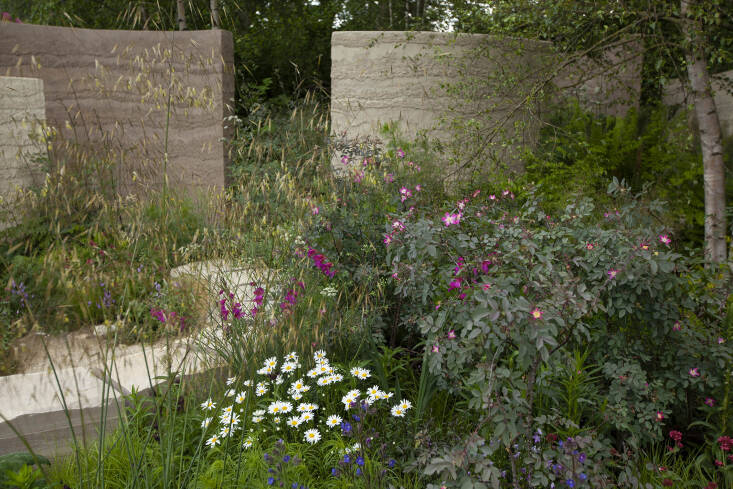Leaves and stems that can be described as “glaucous” have been big this year—not least at the Chelsea Flower Show—with dramatically flowered opium poppy and Sicilian garlic reveling in the waxy textures of late spring. They are a crispy memory now, but the red-leaved rose, Rosa glauca, another show leitmotif, is still going strong and about to enter its next phase as a producer of luscious, rounded red hips. For gardeners who are moving toward making an outdoor space that is more gently wild, Rosa glauca is a good mixer, especially with other plants that require minimal pruning or watering.
Photography by Jim Powell for Gardenista.

R. glauca‘s rose family is listed as “wild” by David Austin, a rose that is native to Central and Southern Europe. It has since been naturalized in more northern climes (and is hardy in USDA zones 3-9). The glaucous rose looks at home in a garden in a way that a wild dog of a rose, such as Rosa canina, might not. Species roses are big, and can be too arching, too thorny, and difficult to place. One of the reasons why Rosa glauca has appeared in various show gardens this year is that it looks wild yet distinguished at the same time.

Rosa glauca is a holder of the RHS Award of Garden Merit, and it is almost unbelievably easy-going for a rose. It stood out in a few New England gardens I saw this summer, even the “ice box of Connecticut” (Norfolk). It takes any soil and any aspect whether sheltered or exposed; it does need full sun but is clearly all right with humidity, the downfall of many old-fashioned roses grown in the United States.

Also called the red-leafed rose, or Rosa glauca ‘Rubrifolia’, R. glauca has a valuable hue and texture in its leaves, which are variously described as grayish-purple, purple-green and mauve-copper. They are united by a kind of verdigris filter to the foliage, that is confusingly described as a bloom. In gardens that are more about texture than corsetry, this silvery tone mixes brilliantly with every kind of contrasting shape and color (including gold), enhanced by R. glauca‘s dark red stems.

Water flows in this calming garden for the mental health charity Mind, but in a low-water landscape, Rosa glauca is a natural with the textural bloom of glaucous or deep red succulents. Its water requirements can be minimal, although like any rose it prefers moist and well-drained rather than simply well-drained. In the latter case, it should be planted in a hummus-rich medium and initially watered before being left to fend for itself. Another plus point: It really doesn’t need to be pruned, except to thin out older stems every now and then, or to cut back anything that seems too vigorous.

The flowers of Rosa glauca are not especially tough, and will not last for a week in a vase. Cut as long sprays however, the foliage, and later the hips, add substance to a display. Growing as shrub roses, they can be about 7-feet tall and wide, which is really why they are now appearing in plant lists for wild gardens. A plant that is airy and wide, and is left alone, provides shelter—a commodity that we too often forget—for birds, mammals, invertebrates, amphibians and reptiles. And there’s more: the simple, open flowers are easy for a pollinator to navigate, while the hips add to autumn’s harvest.

See also:
- Stone and Roses: Asthall Manor in the Cotswolds
- Ramblers: The Most Romantic Rose
- Required Reading: ‘Wild: The Naturalistic Garden’ by Noel Kingsbury









Have a Question or Comment About This Post?
Join the conversation